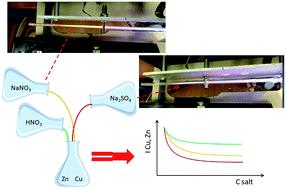当前位置:
X-MOL 学术
›
J. Anal. At. Spectrom.
›
论文详情
Our official English website, www.x-mol.net, welcomes your
feedback! (Note: you will need to create a separate account there.)
Effects of acid, sodium and its salt counterions on the atomic emission of copper and zinc in plasma pencil
Journal of Analytical Atomic Spectrometry ( IF 3.1 ) Pub Date : 2019-10-29 , DOI: 10.1039/c9ja00312f Magda Dvořáková 1, 2, 3, 4, 5 , Aleš Hrdlička 1, 2, 3, 4, 5 , Pavel Slavíček 2, 3, 4, 5, 6 , Viktor Kanický 1, 2, 3, 4, 5
Journal of Analytical Atomic Spectrometry ( IF 3.1 ) Pub Date : 2019-10-29 , DOI: 10.1039/c9ja00312f Magda Dvořáková 1, 2, 3, 4, 5 , Aleš Hrdlička 1, 2, 3, 4, 5 , Pavel Slavíček 2, 3, 4, 5, 6 , Viktor Kanický 1, 2, 3, 4, 5
Affiliation

|
Copper, zinc and sodium atomic line emissions in the plasma of a pencil discharge under the influence of easily ionizable elements (EIE), counterions and nitric acid were studied. These elements were introduced as the water solutions of nitrates and sulfates using an ICP-adopted nebulization system. The plasma pencil as a radiation source was operated in argon at 4 L min−1 powered by a 13.56 MHz generator at 140 W. The most intense depressing effect on the atomic emission of zinc (down to 15% of the unaffected intensity) and copper (down to 35%) appeared with sulfates. A lower effect was observed with chlorides (down to 70% for Zn and 30% for Cu) and the lowest effect was observed with nitrates, which increased the value for Zn by up to 40% and decreased that for Cu to about 50%. Nitric acid has a certain depression effect down to further 50% with salts, 80% for Cu, and 65% for Zn without salts; it also had a stabilization effect, partially compensating for the depression (double intensity for Cu with NaCl and HNO3 against sole NaCl) by anions and EIE. A combination of nitric acid with an added excess amount of an EIE salt could then provide predictable intensities. Sodium is a representative of EIE and it is a constituent of the introduced nitrate and sulfate salts. The sodium intensity dramatically decreased in the presence of sulfates, which might be a consequence of the reactions and energy exchange with the sulfur species in the plasma.
中文翻译:

酸,钠及其盐类抗衡离子对等离子铅笔中铜和锌原子发射的影响
研究了易电离元素(EIE),抗衡离子和硝酸对铅笔放电等离子体中铜,锌和钠原子线发射的影响。使用采用ICP的雾化系统,将这些元素作为硝酸盐和硫酸盐的水溶液引入。作为辐射源的等离子铅笔在氩气中于4 L min -1下运行由13.56 MHz发电机以140 W功率供电。硫酸盐对锌(低至未受影响强度的15%)和铜(低至35%)的原子发射产生最强烈的抑制作用。用氯化物观察到较低的效果(对于锌下降到70%,对铜下降到30%),而对硝酸盐观察到最低的效果,这使锌的值增加多达40%,而使铜的值下降到约50%。硝酸在不添加盐的情况下具有一定的抑制效果,甚至降低到50%,Cu达到80%,Zn达到65%。它也具有稳定作用,部分补偿了凹陷(含NaCl和HNO 3的Cu的双重强度阴离子和EIE对抗唯一的NaCl)。硝酸与添加过量的EIE盐的组合可以提供可预测的强度。钠是EIE的代表,它是引入的硝酸盐和硫酸盐的组成部分。在存在硫酸盐的情况下,钠强度急剧降低,这可能是由于反应和与血浆中的硫物质进行能量交换而造成的。
更新日期:2019-10-29
中文翻译:

酸,钠及其盐类抗衡离子对等离子铅笔中铜和锌原子发射的影响
研究了易电离元素(EIE),抗衡离子和硝酸对铅笔放电等离子体中铜,锌和钠原子线发射的影响。使用采用ICP的雾化系统,将这些元素作为硝酸盐和硫酸盐的水溶液引入。作为辐射源的等离子铅笔在氩气中于4 L min -1下运行由13.56 MHz发电机以140 W功率供电。硫酸盐对锌(低至未受影响强度的15%)和铜(低至35%)的原子发射产生最强烈的抑制作用。用氯化物观察到较低的效果(对于锌下降到70%,对铜下降到30%),而对硝酸盐观察到最低的效果,这使锌的值增加多达40%,而使铜的值下降到约50%。硝酸在不添加盐的情况下具有一定的抑制效果,甚至降低到50%,Cu达到80%,Zn达到65%。它也具有稳定作用,部分补偿了凹陷(含NaCl和HNO 3的Cu的双重强度阴离子和EIE对抗唯一的NaCl)。硝酸与添加过量的EIE盐的组合可以提供可预测的强度。钠是EIE的代表,它是引入的硝酸盐和硫酸盐的组成部分。在存在硫酸盐的情况下,钠强度急剧降低,这可能是由于反应和与血浆中的硫物质进行能量交换而造成的。











































 京公网安备 11010802027423号
京公网安备 11010802027423号